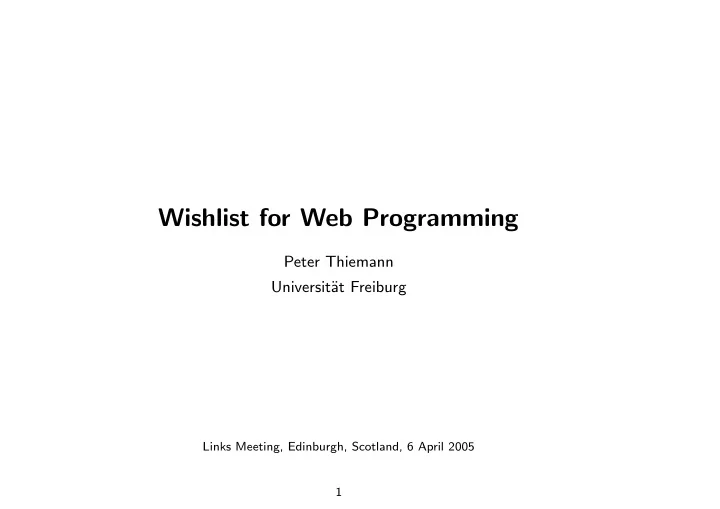

Wishlist for Web Programming Peter Thiemann Universit¨ at Freiburg Links Meeting, Edinburgh, Scotland, 6 April 2005 1
The Structure of Modern Web Sites kinds of content static generated images contents of passive downloads files stylesheets data bases traditional generated executable scripts scripts • Usually a mix • About 50% of all sites have executable content 2
Thesis • More than 90% generated content for some sites (search engines, news services, blogs, . . . ) • Much of it programmed in an ad-hoc way (CGI, Perl, PHP, . . . ) • Appropriate programming technology sorely needed 3
From the Structure . . . static/passive ⇒ web server generated/passive • access to input • database and file access • computation • output generation: templates, transformations static/executable ⇒ web server • does it fit with the static parts? generated/executable computation ⇒ meta programming 4
Wishlist • programming model – session concept – callback concept – composition of functional components (parameterization) – quality assurance (type safety) – support for programming in the large (abstraction, parameterization) • features – XML generation – database access – support for transactions – XML processing (mostly for Web services) – email, instant messaging – other APIs (Java based?) 5
Subjective Reflection • some systems, e.g. , BigWig, JWig, WASH, PLT-Scheme, . . . – deliver on the programming model – do not score highly on features ⇒ consequently, they are not widely used • PHP (Perl, Python) – score badly on the programming model/maintenance/. . . ∗ unchecked string references (href and action attributes) between pages ∗ retrieval of input fields through unchecked strings ∗ input delivered in terms of strings – feature-laden; easy access to Java APIs – leading deliverator of dynamic content on the web today • JSP scores better in all respects, but is much less frequently used 6
What Seems to Make a Web Programming Technology Successful . . . Features , Features , Features plus • Familiar concepts (kills WASH) • Low learning curve (kills WASH, *Wig, JSP) • Seamless integration (kills BigWig) • Ease of development and deployment (kills JSP) 7
How to sell technology like WASH? • keep the features but change the host language to JavaScript – fix up quirks of the language – add static typing; nominal types (classes); constrained polymorphism • integrate server-side scripting with client-side scripting – less diversity in application development – interaction between client and server part of application checkable by compiler • migration path: untyped ⇒ typed islands ⇒ fully typed 8
On JavaScript • industry standard (EcmaScript) • right visibility and apparent familiarity (it has objects) • low learning curve • rich feature set • libraries available • client-side applications abundant • server-side: existing application servers as backend ( whitebeam.org , helma.org , cocoon.apache.org ) • but a weak dynamic type system 9
Example Web Script • Display a time-dependent greeting • Read in a name and echo a personalized greeting • Two styles 1. Presentation and application logic muddled up 2. Clean separation between presentation (skin) and application ⇒ Observe that skins are pure HTML ⇒ Designers need not know about programming technology 10
function main () { var today = getDate (); ask <html><head><title>Greeting</title></head> <body><p>Today is { today } <input type="submit" name=" { daytime (today) } " /></p> <p>Enter your name <input type="text" name=" { who } " /> <input type="submit" name=" { greet (who) } " /></p> </body> </html> } function daytime (date) { var currentTime = getTime (); var what = phrase (currentTime); ask <html><head><title>Daytime</title></head> <body>It’s { what } of { date } ! </body> </html> } function greet (who) { ask <html><head><title>Greeting</title></head> <body>Hello, { who } ! </body> </html> } 11
function mainSkin (today) { function main () { <html><head><title>Greeting</title></head><body> var today = getDate (); <p>Today is { today } ask (mainSkin (today)) <input type="submit" name=" { daytime (today) } " /></p> } <p>Enter your name <input type="text" name=" { who } " /> <input type="submit" name=" { greet (who) } " /></p> </body> </html> } function daySkin (what, date) { function daytime (date) { <html><head><title>Daytime</title></head> var curTime = getTime (); <body>It’s { what } of { date } ! var what = phrase (curTime); </body> ask (daySkin (what, date)) </html> } } function greetSkin (who) { function greet (who) { <html><head><title>Greeting</title></head> ask (greetSkin (who)) <body>Hello, { who } ! } </body> </html> } 12
From JavaScript to WASH/JS • JavaScript is untyped ⇒ create type system and/or static analysis ⇒ leads to “better JavaScript” ⇒ helps discover errors in existing programs ⇒ see paper @ ESOP’05 • JavaScript is interpreted ⇒ create compiler for suitable subset ⇒ can exploit analysis results • JavaScript is weird ⇒ No, the browsers’ object hierarchy differs between vendors ⇒ Well, see the ESOP paper 13
Recommend
More recommend